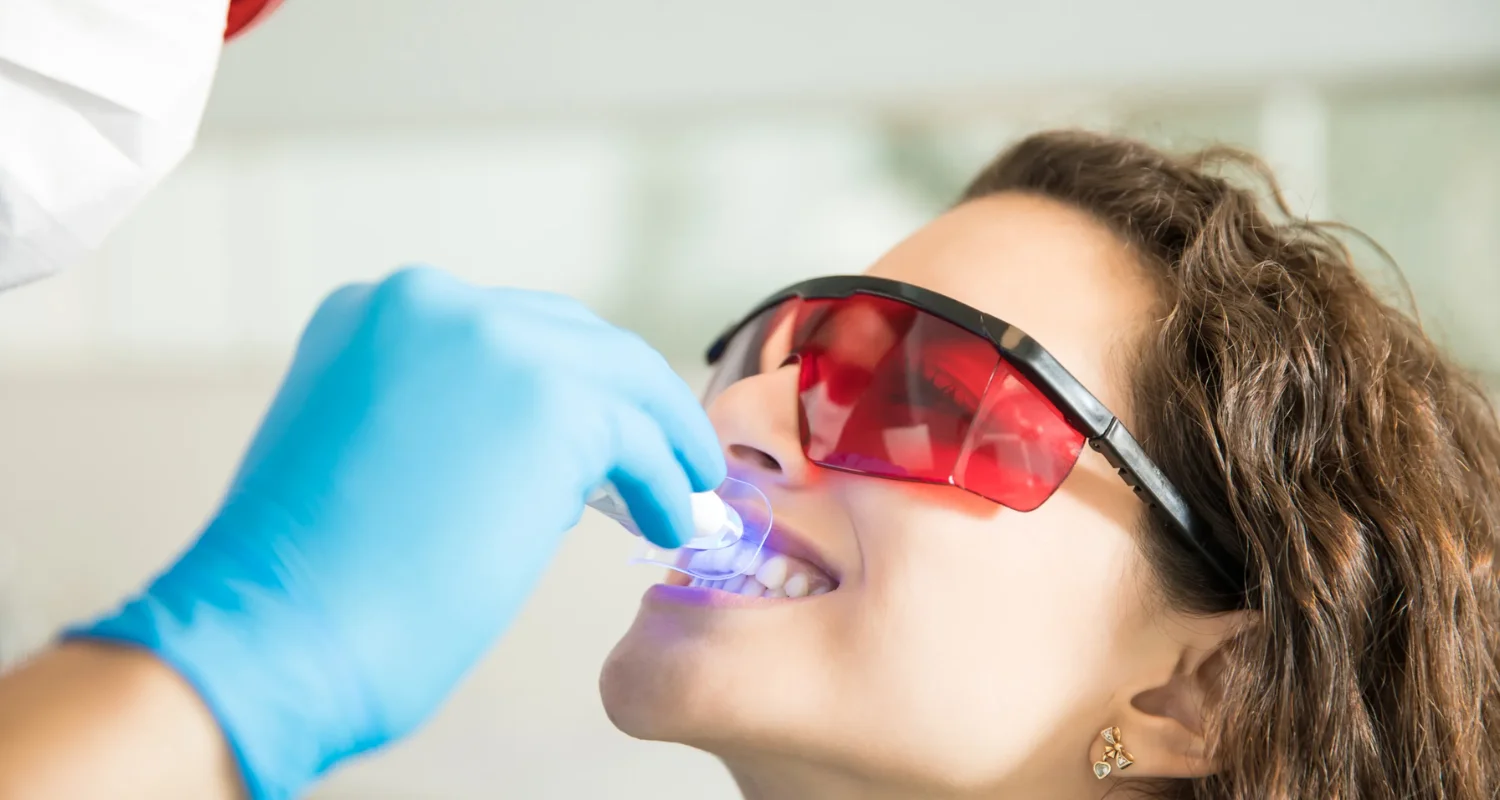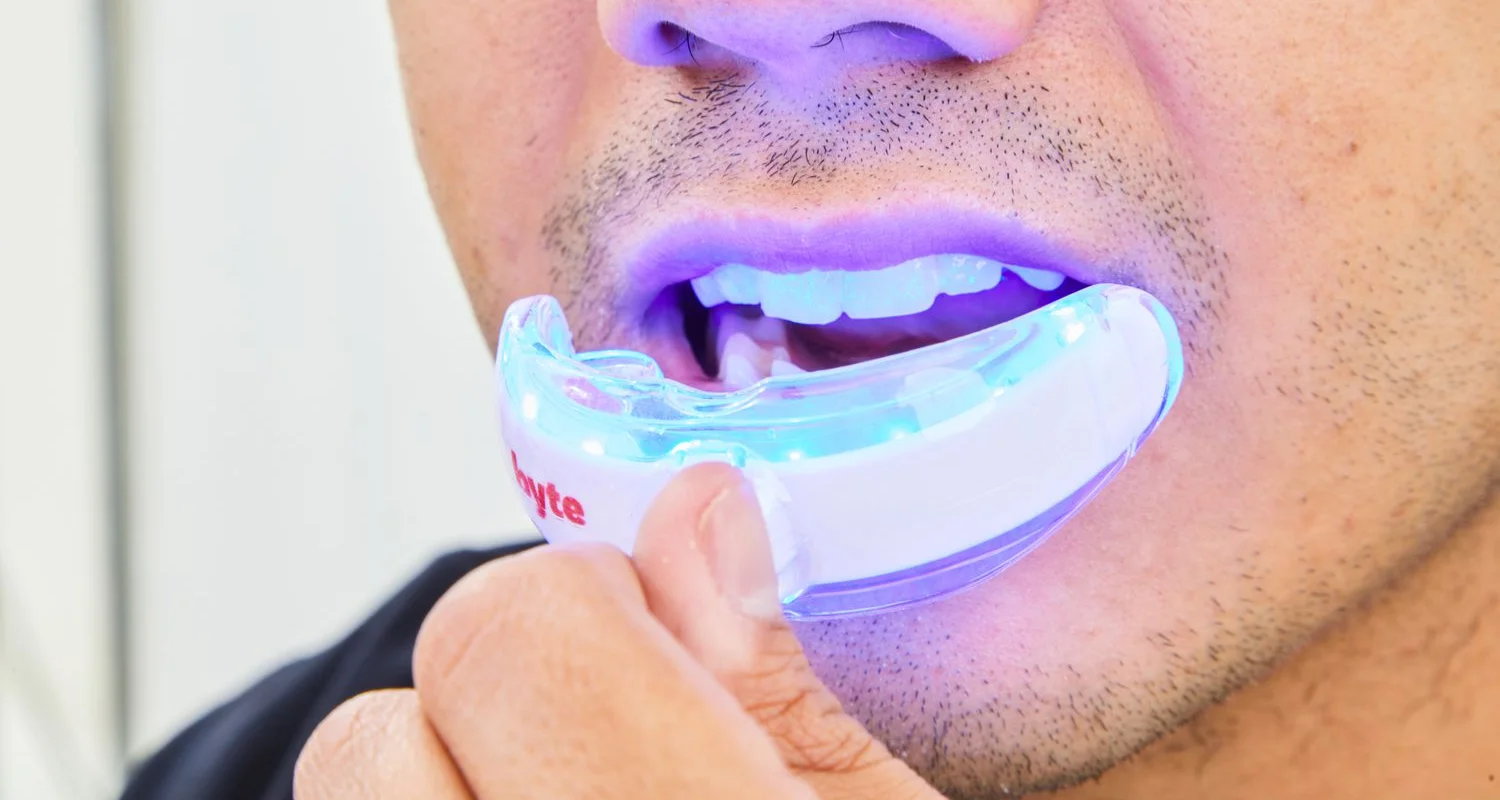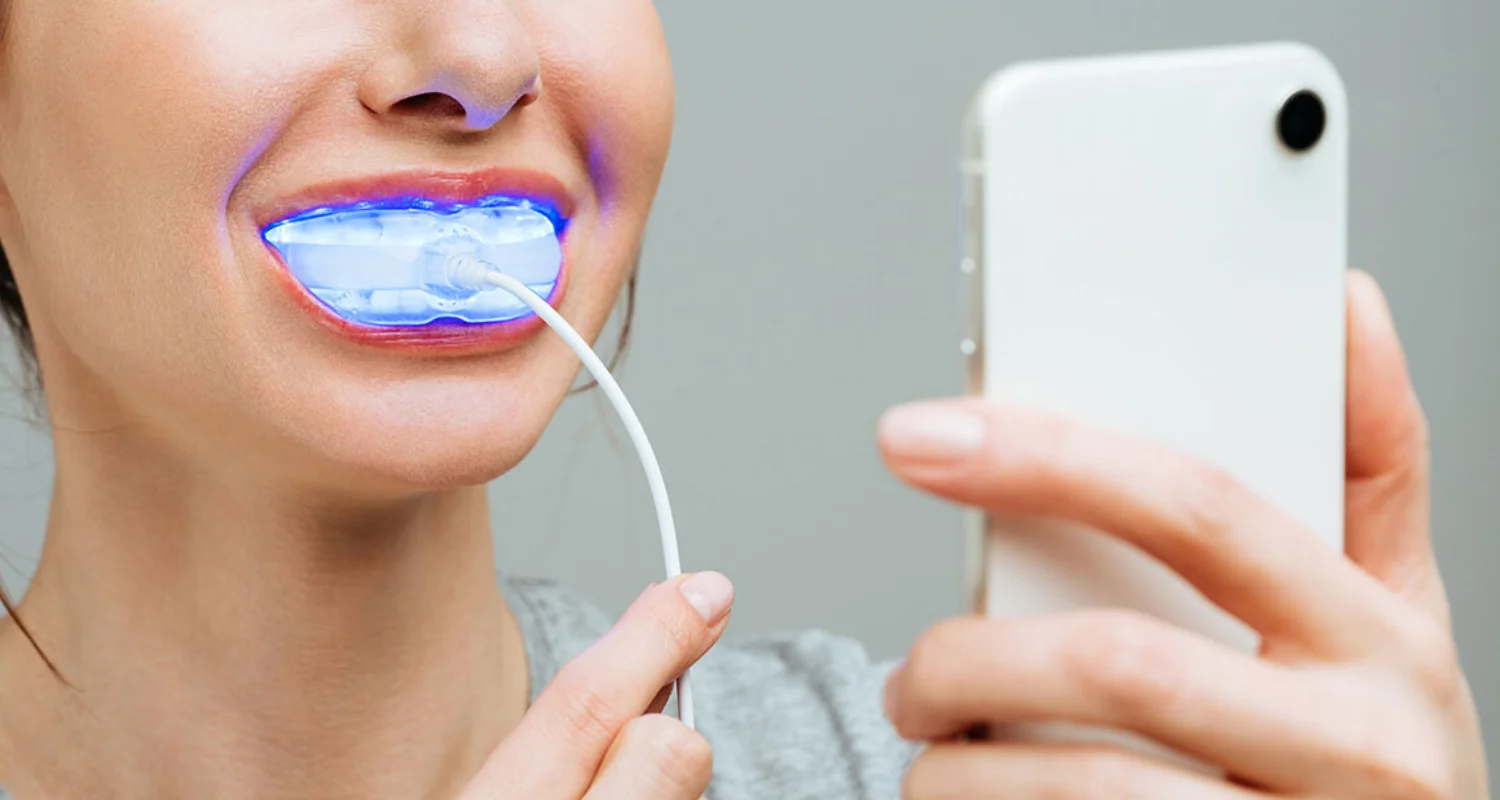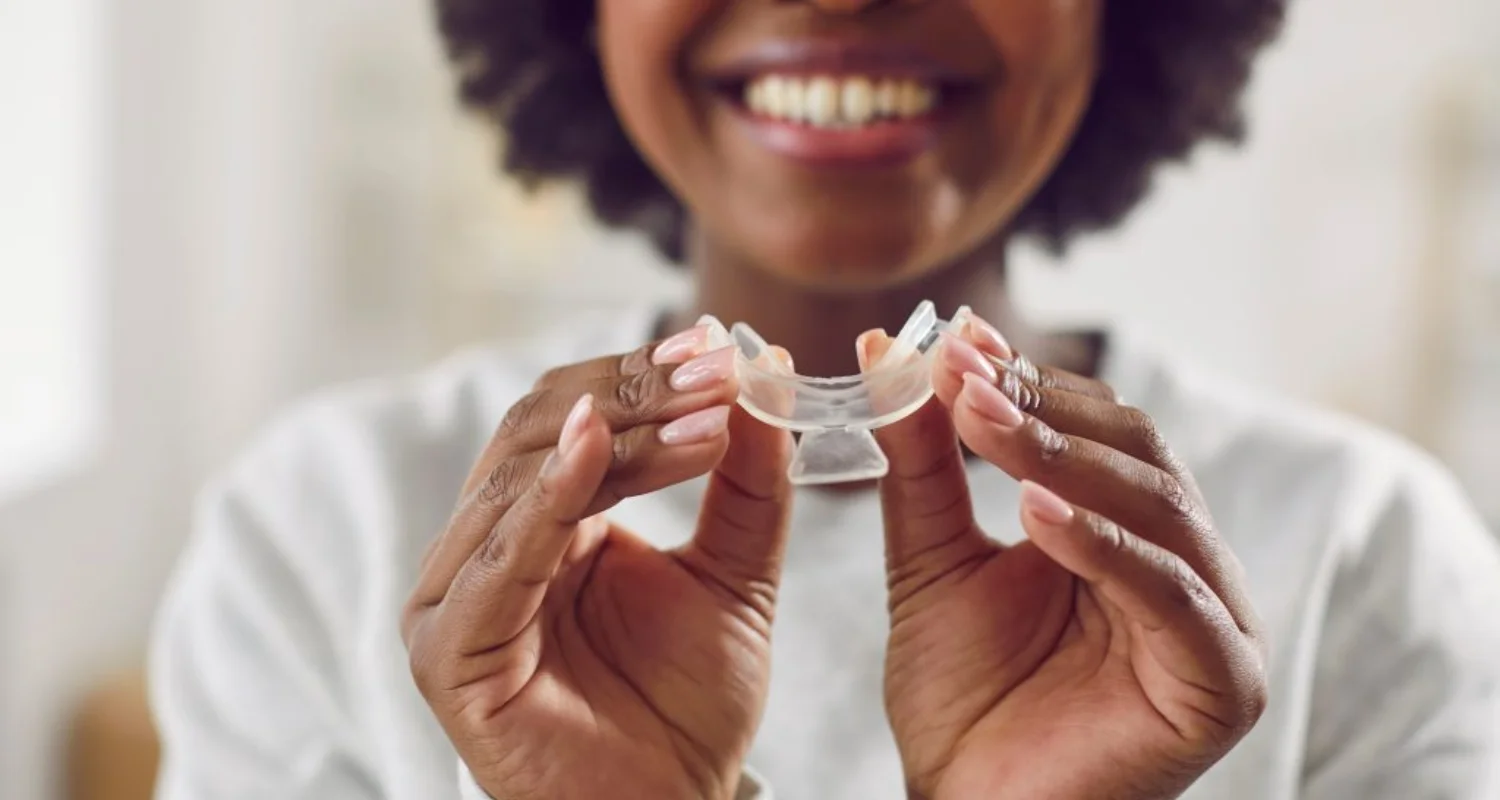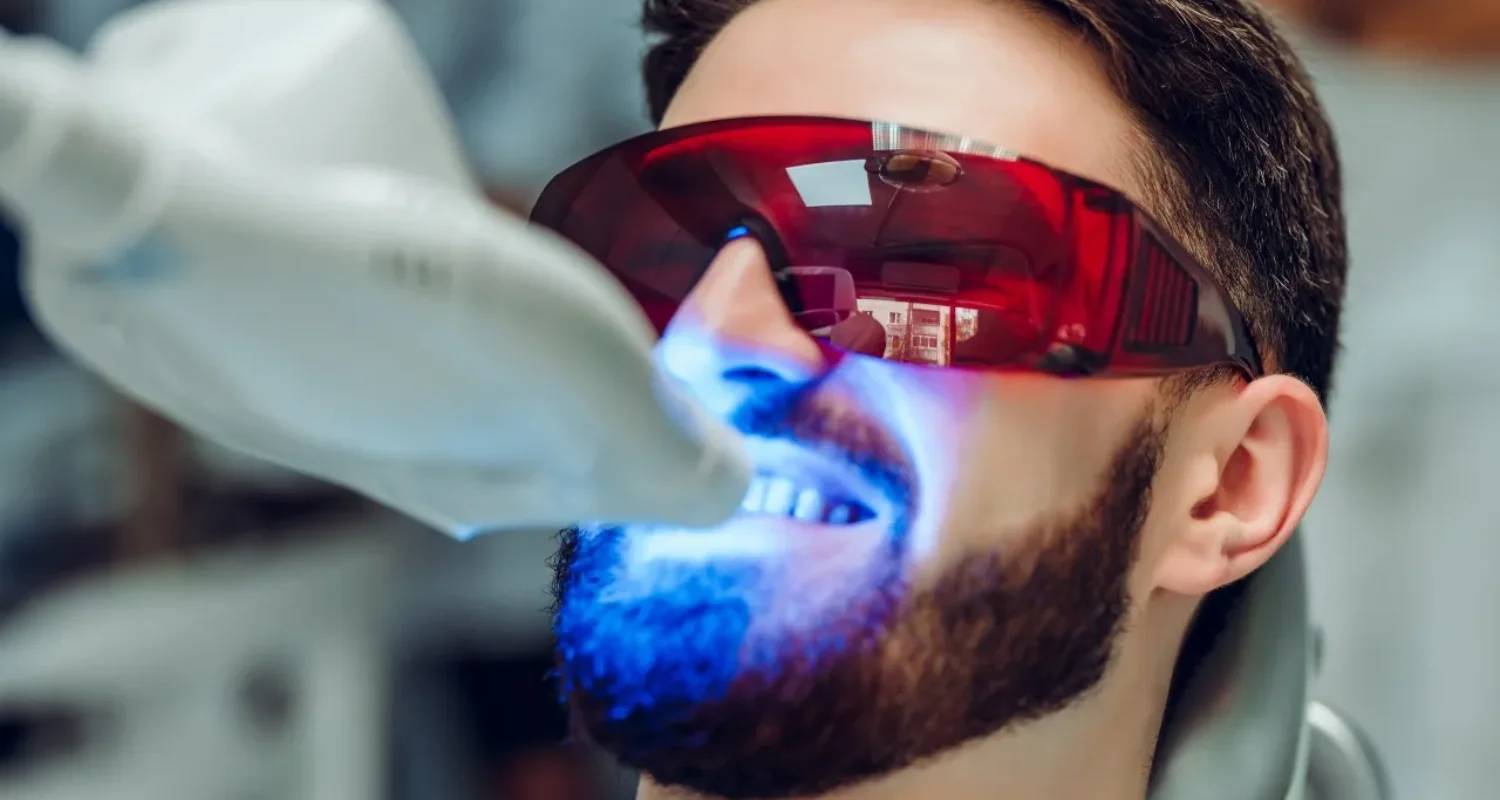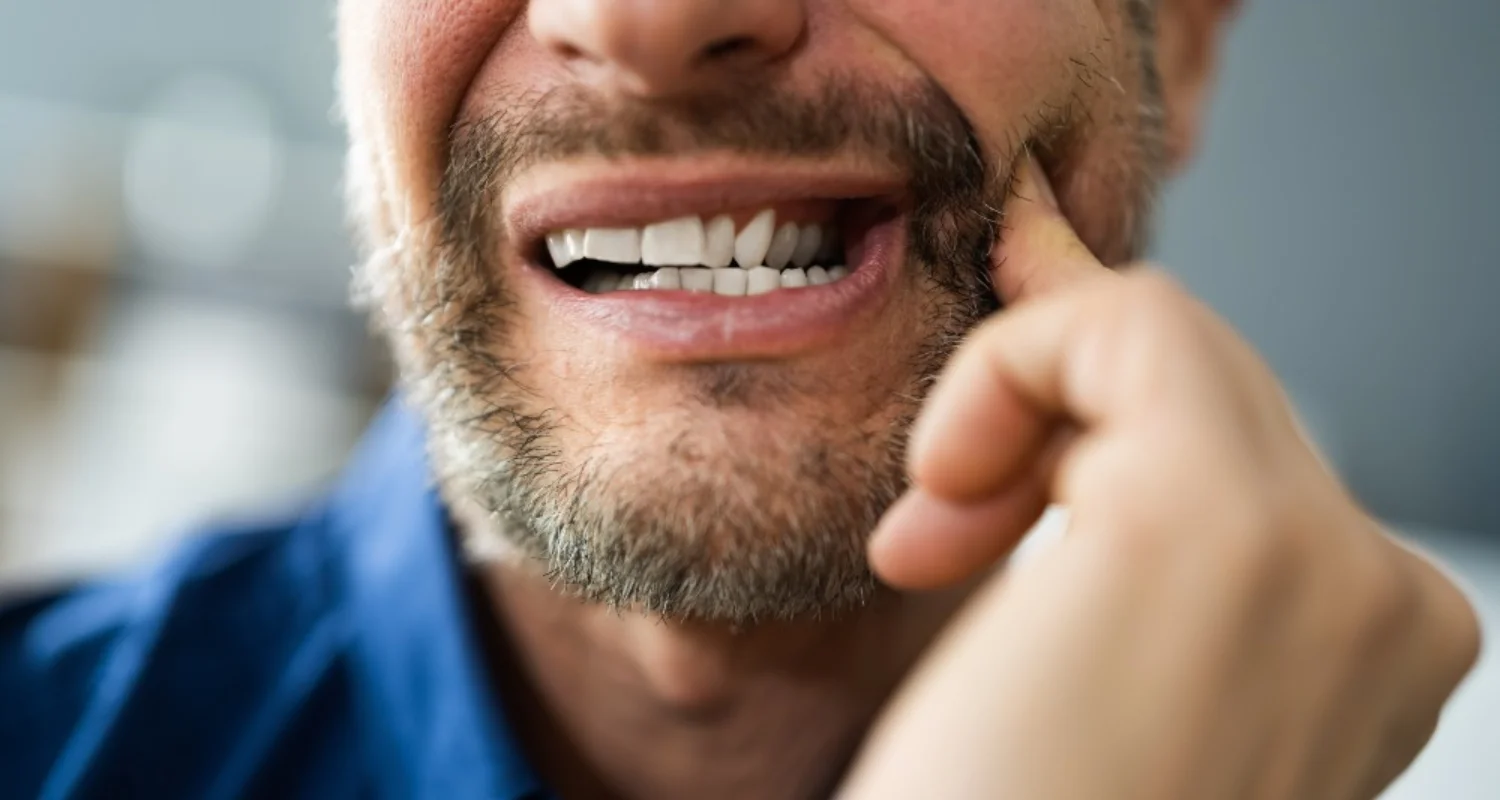Last Updated on: 19th September 2025, 12:35 pm
LED teeth whitening has established itself as one of the most popular techniques for achieving a whiter, more radiant smile. This method combines specialized whitening gels with high-intensity LED light to boost results safely and efficiently. Its main purpose is to reduce stains on teeth caused by food, drinks or habits such as tobacco, improving dental aesthetics and personal confidence.
Its growing popularity is due to its effectiveness and convenience. Compared to other methods, LED teeth whitening offers visible results in less time, making it an attractive option for those looking for a quick and effective solution. In addition, it is known to be less aggressive on tooth enamel, making it ideal even for people with sensitive teeth.
LED teeth whitening is used both in dental offices and as home treatments. In clinics, dentists apply more concentrated gels under professional supervision to ensure optimal and safe results. On the other hand, home-use kits, designed with a lower concentration of whitening agents, allow users to perform treatments comfortably from home, adapting to their schedules and needs.
How does LED teeth whitening work?
The LED light mechanism during teeth whitening is to activate the bleaching agents applied to the teeth such as hydrogen peroxide or carbamide peroxide. LED light helps break down the gel faster by emitting a specific wavelength and increasing the temperature, resulting in a chemical reaction forming free radicals that remove stains from the teeth.
Is LED teeth whitening safe?
LED teeth whitening is generally safe when performed under the supervision of a dental professional. Dentists use approved products and equipment that have been proven effective and safe for tooth enamel and gums. However, temporary side effects may occur, such as tooth sensitivity and gum irritation, which usually disappear shortly after treatment.
It is important to note that the FDA regulates teeth whitening products. When purchasing products for home use, it is recommended to look for those that are approved by both the FDA and the ADA. However, the ADA has not published specific findings on the safety of LED lights for home whitening.
Incorrect use of these products can lead to risks, such as increased tooth sensitivity, enamel damage, or gum irritation. Therefore, it is essential to follow the instructions provided and not exceed the recommended application times. In addition, it is advisable to avoid treatments offered by non-professionals in unauthorized locations, as they may not meet appropriate safety standards.
Pros and cons of LED teeth whitening
Pros
● Fast and effective results: Significant improvements can be seen from the first session. In a single session, the enamel tone can be considerably lightened. LED lamps are designed to cover a wide surface, ensuring that all teeth are treated evenly.
● Greater comfort: The LED lamp emits a cold light that generates less heat, which decreases tooth sensitivity and reduces the risk of damaging the enamel.
● Satisfactory results: This treatment offers visible whitening with little effort and in a short time.
● Improved oral care habits: During the session, professionals usually provide recommendations on hygiene and nutrition, essential not only to maintain the achieved whiteness, but also to improve overall oral health.
Cons
● Possible temporary sensitivity: During and after treatment, it is common to experience tooth sensitivity due to exposure to light. However, this effect is usually temporary and disappears in a short time.
● Dietary restrictions: During treatment, it is necessary to avoid foods and drinks with colorants, both natural and artificial. This is because the enamel pores become open and are more susceptible to stains. It is also advisable to refrain from consuming sugary drinks, using coloured toothpaste or mouthwash and avoiding harmful habits such as smoking or drinking alcohol.
LED Teeth Whitening vs. Other At-Home Teeth Whitening Treatments
LED whitening vs. whitening toothpastes
● LED whitening: Offers fast and deep results, lightening several shades in a single session. Ideal for stubborn stains. Occasionally used in clinics or with home kits, due to its intensity.
● Whitening pastes: Remove surface stains with prolonged use, but do not lighten enamel in depth. Designed for daily use, they help maintain color and prevent new stains.
LED whitening is ideal for fast results; pastes are better for daily maintenance. Using them together can maximize benefits.
LED whitening vs. whitening strips
● LED whitening: It’s simple, performed by professionals in clinics or with easy-to-apply home kits. LED light activates whitening agents for fast, visible results, lightening several shades in just a few sessions, ideal for deep stains.
● Whitening strips: These are hydrogen peroxide-free, use essential oils such as coconut, sage, lemon peel, and Dead Sea salt. Use for 30 minutes for 7 days and then 1-2 times a week, ideal for surface stains. It is recommended to store them in cool areas, as they tend to become sticky in warm environments.
LED whitening vs. whitening pens
● LED whitening: easy, fast, and effective (as explained above)
● Whitening pens: Contain a 4-ingredient serum: hydrogen peroxide, alcohol solvent, copolymer, and water. Vegan, sugarfree, and gluten-free. Easy to use, you clean the surface of the tooth and then apply the serum inside the pen. Use 2-4 times a day for about 10 minutes.
LED Whitening vs. home remedies
● LED whitening: Offers fast and visible results, lightening several shades in just a few sessions, thanks to the activation of whitening agents. When performed supervised and correctly, it is safe.
● Home remedies: Such as baking soda or activated charcoal, are less effective and usually only remove superficial stains. They can be abrasive, wearing down tooth enamel and increasing sensitivity, especially with prolonged or incorrect use.
LED whitening vs. laser whitening
● LED whitening: Less expensive, priced between $300 to $600 per session, typically requiring multiple sessions of 60 to 90 minutes each to achieve the desired shade. It is widely accessible and can be performed in both dental offices and through kits for home use, although professional supervision is recommended to ensure safety and effectiveness.
● Laser whitening: More expensive, priced between $600 to $1,500 per session, providing visible results in a single session of about an hour, thanks to the intensity of the light used. It is a more specialized procedure that is typically performed exclusively in dental offices by trained professionals, limiting its availability for some patients.
Side effects of LED Teeth Whitening
Despite being safe and conservative, LED teeth whitening treatment can present the following side effects:
● Longevity: the duration and success of whitening in vital and non-vital teeth will depend on the patient’s habits and whether or not he or she complies with the instructions given by the dentist.
● Dental sensitivity: it may be related to the passage of hydrogen peroxide through the enamel to the dentin, causing a slight irritation to the pulp. Whitening is contraindicated for those people who already have dental sensitivity prior to the treatment.
● Gum irritation: If the peroxide concentration is high and touches the gums, it causes irritation to the gums. To reduce the irritation, the peroxide concentration can be reduced or the exposure time can be reduced. If the product is ingested, it can cause gastric and throat irritation. If the treatment is being done at home and this problem persists for days, it should be suspended for a few days while it improves.
Conclusion
LED teeth whitening has revolutionized the quest for a brighter smile, offering fast and effective results to reduce stains and improve dental aesthetics. Whether performed in a dental office or through home-use kits, this method combines convenience with noticeable improvements, making it an ideal choice for many people seeking a radiant smile.
However, achieving and maintaining these results requires careful adherence to dental recommendations and consistent oral hygiene routines. Combining LED whitening with proper brushing, flossing, and regular dental checkups ensures long-lasting benefits and minimizes potential side effects. By prioritizing both professional guidance and diligent care, you can enjoy a whiter, healthier smile that truly shines.
Frequently Asked Questions
Does the LED teeth whitening system/whitening kit work?
Yes, LED teeth whitening systems and kits are effective in reducing stains and lightening tooth color. They work by combining whitening agents, such as hydrogen peroxide, with LED light, which accelerates the whitening process. While professional treatments offer more dramatic results, home kits can also provide noticeable improvements with consistent use.
Is LED teeth whitening safe?
LED teeth whitening is generally safe when performed under professional supervision or when following the instructions of FDA-approved home kits. However, potential temporary side effects, such as tooth sensitivity or gum irritation, may occur. These typically subside shortly after treatment.
How long do the results of LED teeth whitening last?
The longevity of LED whitening results varies depending on individual habits, such as diet and oral hygiene. Avoiding staining foods and drinks, along with maintaining good oral care practices, can extend the results for several months.
Can LED whitening be done on sensitive teeth?
Yes, LED whitening is suitable for individuals with sensitive teeth due to its gentle nature compared to other whitening methods. Using desensitizing toothpaste before and after treatment can help minimize discomfort.
Is professional LED whitening better than home kits?
Professional LED whitening typically yields faster and more dramatic results due to the use of higher-concentration whitening agents and expert application. Home kits are more convenient and affordable but may take longer to achieve similar results.
Share
References
1. Baroudi, K., & Hassan, N. (2014). The effect of light-activation sources on tooth bleaching. Nigerian Medical Journal, 55(5), 363. https://journals.lww.com/nimj/fulltext/2014/55050/the_effect_of_light_activation_sources_on_tooth.1.aspx
2. Hayward, R., Osman, Y., & Grobler, S. R. (2012). A Clinical Study of the Effectiveness of a Light Emitting Diode System on Tooth Bleaching. The Open Dentistry Journal, 6(1), 143-147. https://doi.org/10.2174/1874210601206010143
3. How Does LED Teeth Whitening Work And Is It Safe? (s. f.). Colgate. Recuperado 30 de agosto de 2024, de https://www.colgate.com/en-us/oral-health/teeth-whitening/led-teeth-whitening-right-for-you
4. Larson, J. (2021, 15 septiembre). Can blue light treatment whiten teeth? Healthline. https://www.healthline.com/health/dental-and-oral-health/blue-light-teeth-whitening#where-to-buy-a-home-kit
5. Pruitt, J. (2024, 3 December). The 12 Best Teeth Whiteners to Tackle Tough Stains. Health. https://www.health.com/condition/oral-health/teeth-whitening-kits
6. Violet LED dental whitening: Effectiveness and biological safety: an in vitro study. (s. f.). Science Direct. Recuperado 4 de septiembre de 2022, de https://www.sciencedirect.com/science/article/abs/pii/S1572100022002514



